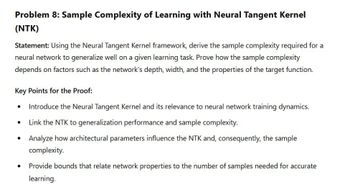
Advanced Engineering Mathematics
10th Edition
ISBN: 9780470458365
Author: Erwin Kreyszig
Publisher: Wiley, John & Sons, Incorporated
expand_more
expand_more
format_list_bulleted
Question

Transcribed Image Text:Problem 8: Sample Complexity of Learning with Neural Tangent Kernel
(NTK)
Statement: Using the Neural Tangent Kernel framework, derive the sample complexity required for a
neural network to generalize well on a given learning task. Prove how the sample complexity
depends on factors such as the network's depth, width, and the properties of the target function.
Key Points for the Proof:
•
Introduce the Neural Tangent Kernel and its relevance to neural network training dynamics.
•
Link the NTK to generalization performance and sample complexity.
Analyze how architectural parameters influence the NTK and, consequently, the sample
complexity.
. Provide bounds that relate network properties to the number of samples needed for accurate
learning.
Expert Solution
This question has been solved!
Explore an expertly crafted, step-by-step solution for a thorough understanding of key concepts.
Step by stepSolved in 2 steps with 3 images

Knowledge Booster
Similar questions
- Explain the Extended Least Squares Assumptions?arrow_forwardWhat does it mean if the assumptions of ordinary least squares estimator are not met? -Why is this a concern?arrow_forwardFigure 1 shows the results of the statistical test without interaction term between Region and Design (aov1), and the statistical test with interaction term between Region and Design (aov2) as R output for this problem. Figure 1. R output of model results for two statistical models, one without an interaction term between Design and Region (aov1) and one with interaction term between Design and Region (aov2). aovi F) 83.42 5.56e-13 *** 22.27 8. 80e-08 *** 42495 signif. codes: 0 ****' 0.001 ***' 0.01 **' 0.05 '.' 0.1 ''1 aov2 F) þesign Region þesign:Region 6 Residuals 3 94638 8248 34247 31546 22.107 4. 34e-07 *** 0. 963 1375 1427 0.47 24 --- signif. codes: O *** 0.001 0. 01 * 0.05 .' 0.1'1 Using a significant at the significance level alpha = 0.05, based on Figure 1 which statement is correct? %D The model without interaction (aov1) shows that the factors Design and Region are not significant with regards to their impact on survey responses at the selected significance level. The model…arrow_forward
- Define the concept of Weighted Least Squares?arrow_forwardExplain in detail the approach of Weighted Least Square used by applied economiststo address heteroskedasticity in empirical work.arrow_forwardHello. Please answer the attached Linear Algebra question and its 2 parts correctly & completely. Please show all of your work for each part. *If you answer the question and its 2 parts correctly & show all of your work, I will give you a thumbs up. Thanks.arrow_forward
- 9. Suppose you use p features X1, ., Xp to predict the probabilities of K classes by the multi- class logistic regression model. Formulate it as a feed-forward neural network. Draw the model and point out the activation function.arrow_forwardAn engineer is testing a new car model to determine how its fuel efficiency, measured in L/(100 km), is related to its speed, which is measured in km/hour. The engineer calculates the average speed for 30 trials. The average speed is an example of a (statistic or parameter) The engineer would like to find the least squares regression line predicting fuel used (y) from speed (x) for the 30 cars he observed. He collected the data below. Speed 62 65 80 82 85 87 90 96 98 100 Fuel 12 13 14 13 14 14 15 15 16 15 Speed 100 102 104 107 112 114 114 117 121 122 Fuel 16 17 16 17 18 17 18 17 18 19 Speed 124 127 127 130 132 137 138 142 144 150 Fuel 18 19 20 19 21 23 22 23 24 26 The regression line equation is Round each number to four decimal places.arrow_forwardInterpret the generated results at 5% level of significance.arrow_forward
arrow_back_ios
SEE MORE QUESTIONS
arrow_forward_ios
Recommended textbooks for you
 Advanced Engineering MathematicsAdvanced MathISBN:9780470458365Author:Erwin KreyszigPublisher:Wiley, John & Sons, Incorporated
Advanced Engineering MathematicsAdvanced MathISBN:9780470458365Author:Erwin KreyszigPublisher:Wiley, John & Sons, Incorporated Numerical Methods for EngineersAdvanced MathISBN:9780073397924Author:Steven C. Chapra Dr., Raymond P. CanalePublisher:McGraw-Hill Education
Numerical Methods for EngineersAdvanced MathISBN:9780073397924Author:Steven C. Chapra Dr., Raymond P. CanalePublisher:McGraw-Hill Education Introductory Mathematics for Engineering Applicat...Advanced MathISBN:9781118141809Author:Nathan KlingbeilPublisher:WILEY
Introductory Mathematics for Engineering Applicat...Advanced MathISBN:9781118141809Author:Nathan KlingbeilPublisher:WILEY Mathematics For Machine TechnologyAdvanced MathISBN:9781337798310Author:Peterson, John.Publisher:Cengage Learning,
Mathematics For Machine TechnologyAdvanced MathISBN:9781337798310Author:Peterson, John.Publisher:Cengage Learning,


Advanced Engineering Mathematics
Advanced Math
ISBN:9780470458365
Author:Erwin Kreyszig
Publisher:Wiley, John & Sons, Incorporated

Numerical Methods for Engineers
Advanced Math
ISBN:9780073397924
Author:Steven C. Chapra Dr., Raymond P. Canale
Publisher:McGraw-Hill Education

Introductory Mathematics for Engineering Applicat...
Advanced Math
ISBN:9781118141809
Author:Nathan Klingbeil
Publisher:WILEY

Mathematics For Machine Technology
Advanced Math
ISBN:9781337798310
Author:Peterson, John.
Publisher:Cengage Learning,

